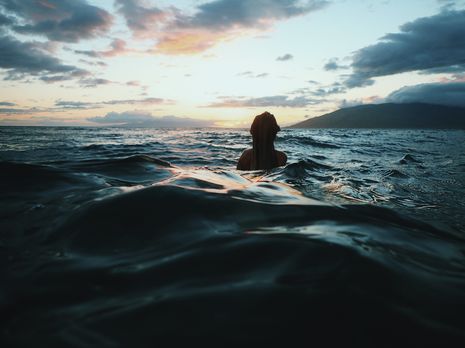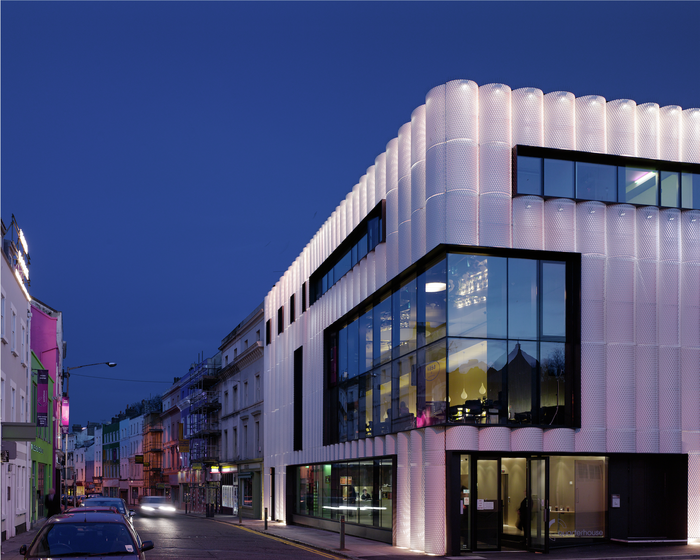‘A veritable sea of remarkable work’: Queens’ Arts Festival
Staff writer Rosa Phelps reviews this year’s Queens’ Arts Festival, ‘Lost but Not at Sea’

On the opening night of 2022’s incarnation of Queen’s Arts Festival, I am met by curator, Tara Panesar. A glass of wine in hand, she is wearing an elegant but boldly bright red dress. As we move through the Fitzpatrick gallery, it quickly emerges that ‘Lost but Not at Sea’, an exhibition of experimental student art, matches this ambience perfectly: improbably but successfully expressing pared-back elegance and intense exuberance at the same time.
“Each individual piece has been thoughtfully placed in context of neighbouring works”
The exhibit’s theme, ‘Lost but Not at Sea’, stands out for its thoughtful originality amid the abundance of recycled prompts that dominate the Cambridge creative scene. The phrase was chosen by the team in part because of the ambiguity of its connotations. The plethora of different interpretations on display is a testament to the wisdom of their choice and to the deep creativity of Anglia Ruskin and University of Cambridge students. The variation here is not only thematic; there is an impressively broad range of mediums on display: photography and paintings, of course, but also a zine, poems, two short films, pottery, and memorably a hand-made gown with human hair sewn onto it. One room’s display is accompanied by two soundscapes by student DJs Eliza Pepper and Fergus Holmes-Stanley, playing on an alternating loop. Immran by Holmes-Stanley, inspired by the isolation of medieval Gaelic monks, amplifies images of remote wildernesses on display nearby, revealing how powerful artistic combinations of audio and visual mediums can be.
Tara explains that the order of the exhibition is loosely structured around broad categories which surfaced recurrently in submissions. As viewers enter the gallery, they are greeted by pieces that centre on interiority, most commonly on the sensation of being lost within one’s mind. As the viewer walks along the balcony-corridor which comprises the first section of the exhibition space, the focus shifts to bodies and physical health. Finally, we enter a section based on exteriors, with pieces centred on people in urban and rural spaces, and spaces entirely devoid of humans. These broad divisions are fluid and gradual rather than restrictively definitive, leaving space for viewers to draw their own conclusions about works’ meanings and to consider the ways in which different ‘sections’ overlap and interact. Each individual piece has been thoughtfully placed in context of neighbouring works in ways that serve to create interesting visual and intellectual juxtapositions or echoes.
Student-run creative events in Cambridge all too often veer into self-congratulating pretension, but the Arts Festival deftly side-steps the pitfall of taking itself too seriously. Despite its philosophical title, Winnie Zhu’s photograph of bananas in Sainsbury’s, Where do I come from and Where are we going?, provides a wonderful reminder that sometimes art should be absurd and playful. Reading Renee Eshel’s confessional and eclectic zine, Rebirth, I found myself cackling at the diary fragment, ‘I can’t believe I have to navigate boundaries for the rest of my fucking existence’. Same, girl.
That’s not to say that the exhibit shies away from difficult topics – far from it. The powerful opening piece is Alma Popescu’s Neuronal Loss, composed of an enlarged image of a healthy brain alongside a brain severely affected by Alzheimer’s. On such a large scale, their intricate whorls are mesmerising. Serendipitously, my visit to the gallery coincides with that of featured photographer Neel Sureja, who is completing a Masters in conservation at Anglia Ruskin. He tells me that his precisely composed, pristinely focused photos aim to give concrete visual embodiment to the tragedy of climate change, an issue so huge in scale that it is difficult for us to conceptualise and consequently easy for us to ignore. If my visceral reaction is anything to go by, his photos amply succeed. The exceptional Man Made Threat to Nature is particularly effective, capturing two increasingly rare black-winged stilts soaring amongst billowing clouds of factory fumes. Another moment of keen poignancy comes with a pastel painting of clouds on a piece of rough wood by Benedict Zombory-Moldovan, the festival’s co-president. Aesthetically stunning as a stand-alone piece, the extra layer of meaning evoked by its striking title, View of the sky over the hill where my dad and I would like our ashes to be scattered, renders it exquisitely moving.
At this year’s Queens Arts Festival, there are no misses. This phenomenally curated exhibit epitomises the potential of creativity to make both artists and viewers feel together in our loneliness, even (and perhaps most of all) at the moments we are most lost. This article has only begun to delve into describing the veritable sea of remarkable work on display (pun intended). After losing themselves in student creativity, I’m sure that each attendee left the exhibition feeling a little bit less adrift.
 News / Cambridge academics stand out in King’s 2026 Honours List2 January 2026
News / Cambridge academics stand out in King’s 2026 Honours List2 January 2026 Interviews / You don’t need to peak at Cambridge, says Robin Harding31 December 2025
Interviews / You don’t need to peak at Cambridge, says Robin Harding31 December 2025 Comment / What happened to men at Cambridge?31 December 2025
Comment / What happened to men at Cambridge?31 December 2025 Features / “It’s a momentary expression of rage”: reforming democracy from Cambridge4 January 2026
Features / “It’s a momentary expression of rage”: reforming democracy from Cambridge4 January 2026 News / Varsity’s biggest stories of 202531 December 2025
News / Varsity’s biggest stories of 202531 December 2025










